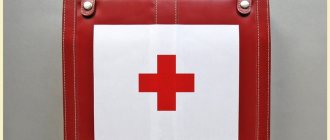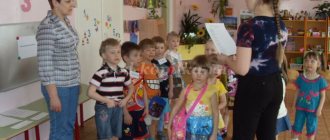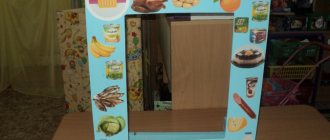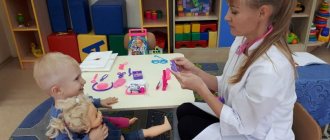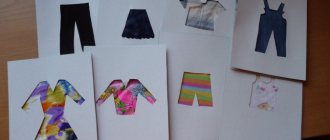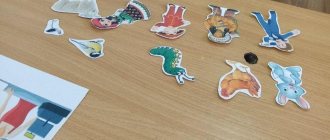MAGAZINE Preschooler.RF
Summary of the plot-role-playing game “Polyclinic” in the senior groupAuthors:
- Tereshchenko Elena Mikhailovna,
- Korosteleva Leili Artashevna,
Educators of MADOU No. 23, Krasnodar region, Armavir
Goal: to expand children’s understanding of the professions of a doctor, a nurse, and their caring attitude towards sick people.
Tasks:
Developmental: consolidate knowledge of social relationships, teach behavior skills in the clinic, develop playful dialogue, playful interaction; activate and expand your vocabulary.
Educational: instill in children a sense of gratitude to a person for his work.
Vocabulary work: complain, phonendoscope, spatula, registry, registrar.
Preliminary work: reading the fairy tale by K. I. Chukovsky “Aibolit” ; conversation about the work of a doctor, nurse; plot-role-playing game “Hospital” .
Materials and equipment: Clothes: 3 robes, 3 hats (for children);
Medical instruments: syringes, phonendoscope, vials, spatula, cotton wool, thermometer, bandage.
Documentation: medical records for each “patient” ; Each child patient wears badges with geometric shapes.
Progress of the game:
Children sit in a group on chairs.
Educator: Guys, today we will play an interesting game - “clinic” . How many of you have been to the clinic? Let's remember what we saw there?
Children: Doctor, nurse, giving an injection.
Educator: Who can tell me why people come to the clinic? When do they arrive?
Children: When they are sick, to get better.
Educator: We come to the clinic and say that something hurts. What is it called?
Children: Complain.
Educator: That's right, the doctor asks: “What are you complaining about?” . Guys, when we come to the clinic, we don’t immediately go to the doctor. First we need to take a medical card - we go to the registry. There is a nurse receptionist sitting there who asks for your last name, first name, and home address. And only then will she give you a medical card. The receptionist also answers phone calls, because someone can call a doctor at home. Then we take turns going into the doctor’s office with the medical card.
Let's take a look at the doctor's tools. This instrument is a phonendoscope. (Shows). What does the doctor do with this instrument?
Children: Listens.
Educator: What is he listening to?
Children: Heart, lungs, breathing.
Educator: Correct. And this is a spatula. (Shows). What are they doing?
Children: Look at your throat.
Educator: And this is a neurological hammer. (Shows). What does the doctor do to them?
Children: Knocking on the knee.
Educator: That’s right, this is how the doctor checks the patient’s reflexes. Now let's look at the nurse's tools. I’ll show you, and you’ll tell me what they’re called and what they do.
Children look at the tools: thermometer, syringe, cotton wool, bandage, vitamins, they call them what they are needed for and how to use them.
Educator: Before we start our game, we need to assign roles. How many of you want to be a doctor? nurse? medical registrar? The most responsible of you will be the doctor. You and I have a real clinic.
Choice of roles. The children take their places.
The reception begins.
Children take turns approaching the register, giving their last name, first name, and address. The child medical registrar issues cards. (the same geometric shapes are drawn on the cards as on the badges of child patients). Then the children take turns going to the doctor.
Child doctor: Hello, come in, sit down. What's your last name? What are you complaining about, what hurts?
Sick child: My throat hurts.
Doctor: Let me take a look at you. Open your mouth. Say "ah-ah" . I'll look at you with a spatula. Don't be alarmed. Yes, the neck is red. Go to the nurse. She will put a thermometer and give medicine.
One by one, the children approach either the doctor or the nurse.
The game continues until the last child patient.
Summing up the game:
- Did you like the game?
- Did the children like the doctor? Nurse? Medical registrar? (yes or no, why).
- Did the child like being in the role of a doctor, nurse, medical receptionist and patient?
Educator: Guys, you came to the clinic sad and sick. And now the doctor has treated you, and you have become healthy, mischievous, cheerful, as you were before your illness.
Children are given sweet gifts.
| Next > |
"Home, family"
Objectives: Encourage children to creatively reproduce family life in games. Improve the ability to independently create a game environment for a planned plot. Reveal the moral essence of the activities of adults: a responsible attitude to their responsibilities, mutual assistance and the collective nature of work.
Roles: mother, father, children, grandmother, grandfather.
Game actions: Game problem situations: “When mom and dad are not at home” (taking care of the younger ones, doing feasible homework), “We are preparing for the holiday” (joint activities with the family), “Welcoming guests” (rules for receiving guests, behavior in guests), “Our day off”, etc. Introduce elements of labor into the game: washing doll clothes, mending clothes, cleaning the room. As the game progresses, select and change toys and objects, construct a play environment using a variety of auxiliary materials, use your own homemade products, and use natural materials.
Preliminary work: Reading the story by V. Oseeva “The Magic Word” and subsequent conversation. Assignment for children: learn at home about the work of their parents. A conversation about the work of parents using illustrated material. Creation of the album “Our fathers and mothers are working.” Looking at family photos. A dramatization of S. Mikhalkov’s poem “What do you have?” Children compose stories on the topic “How I live at home.” Conversation on the topic “How I help adults” with the participation of Petrushka. Making attributes for the game with children.
Game materials: household items, dolls.
"Kindergarten"
Objectives: to expand and consolidate children’s ideas about the content of the labor actions of kindergarten employees.
Roles: teacher, junior teacher, speech therapist, head, cook, music director, physical education director, nurse, doctor, children, parents.
Game activities: The teacher receives children, talks with parents, conducts morning exercises, classes, organizes games... The junior teacher monitors order in the group, assists the teacher in preparing for classes, receives food... The speech therapist works with children on sound production, speech development... Music . the leader conducts music. class. The doctor examines the children, listens, and makes prescriptions. The nurse weighs, measures children, gives vaccinations, injections, gives pills, checks the cleanliness of groups and kitchens. The cook prepares food and gives it to the teacher's assistants.
Game situations: “Morning appointment”, “Our classes”, “On a walk”, “At a music lesson”, “At a physical education lesson”, “Doctor’s examination”, “Lunch in the kindergarten”, etc.
Preliminary work: Observation of the work of the teacher, assistant teacher. Conversation with children about the work of a teacher, assistant teacher, cook, nurse and other kindergarten workers. Excursion-inspection of the music (physical education) hall, followed by a conversation about the work of muses. manager (physical supervisor). Excursion-inspection of medical. office, observation of the doctor’s work, conversations from the personal experiences of children. Inspection of the kitchen, conversation about technical equipment that makes the work of kitchen workers easier. Game-dramatization based on N. Zabila’s poem “Yasochkin’s kindergarten” using toys. Children write stories on the topic “My best day in kindergarten.” Reading the story “Compote” by N. Artyukhova and talking about the work of those on duty. Using Petrushka, show skits on the topics “Our life in kindergarten”, “Good and bad deeds”. Selection and production of toys for the roles of muses. worker, cook, assistant teacher, nurse.
Game material: notebook for recording children, dolls, furniture, kitchen and dining utensils, cleaning kits, honey. tools, clothes for a cook, doctor, nurse, etc.
“School” Objectives: To expand children’s knowledge about school. Help children master expressive means of role implementation (intonation, facial expressions, gestures). Create your own gaming environment for your intended purpose. To contribute to the formation of the ability to creatively develop game plots. Help children learn some moral standards. Foster fair relationships. Strengthen forms of polite address. Develop friendship, the ability to live and work in a team.
Roles: students, teacher, school director, head teacher, technician.
Game actions : The teacher conducts lessons, students answer questions, tell stories, and count. The director (head teacher) is present at the lesson, makes notes in his notebook (the teacher in the role of director can call the teacher to his office and give advice), the head teacher draws up a lesson schedule. The technician monitors the cleanliness of the room and rings the bell. Learn to build a game according to a preliminary, collectively drawn up plot plan. Acting as an equal partner or performing a major (minor) role, indirectly influence changes in the gaming environment and correct gaming relationships. Encourage the construction of interconnected buildings (school, street, park), while correctly distributing the responsibilities of each participant in collective activity.
Preliminary work: Excursion to the school (inspection of the school building and school grounds, inspection of the classroom). Conversation with a 1st grade teacher. Conversation with children about the excursion. A conversation about school supplies using illustrated material. Riddles about school, school supplies. Reading to children the works of S. Marshak “The First of September”, Aleksin “The First Day”, V. Voronkova “Girlfriends Go to School”, E. Moshkovskaya “We Play School”. Memorizing poems by A. Alexandrova “To School”, V. Berestov “Counting Table”. Meeting with kindergarten graduates (organization of leisure activities). Making attributes for the game (briefcases, notebooks, baby books, schedules...)
Game materials: briefcases, books, notebooks, pens, pencils, pointer, cards, blackboard, teacher’s table and chair, globe, teacher’s magazine,
bandages for duty officers.
«Library"
Objectives: display knowledge about the surrounding life in the game, show the social significance of libraries; expand ideas about library workers, establish rules of behavior in a public place; introduce the rules for using the book; awaken interest and love for books, cultivate a caring attitude towards them.
Roles: librarian, readers.
Game activities: Registration of reader forms. Librarian accepting applications. Working with a card index. Issuance of books. Reading room.
Preliminary work: Excursion to the library followed by a conversation. Reading the work of S. Zhupanin “I am a librarian”, opening a “Book Workshop” for book repair. Making pockets in books and forms. Exhibition of drawings based on the works read.
Game material: forms, books, card index.
